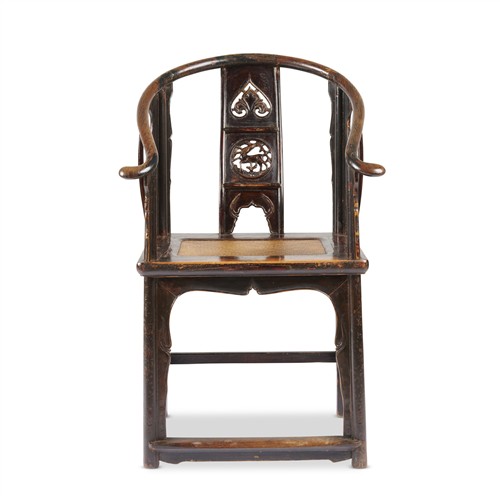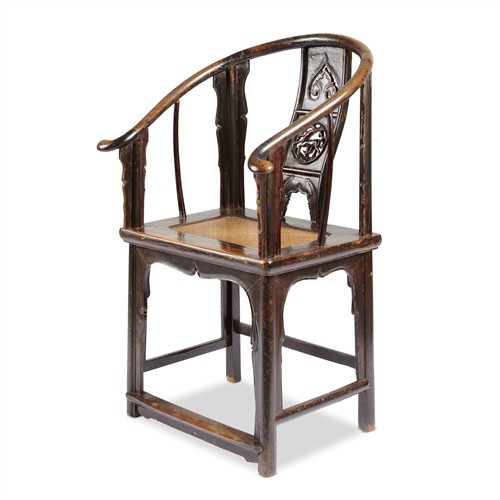Back
A CHINESE LACQUERED AND CARVED HORSESHOE-BACK ARMCHAIR (QUANYI) QING DYNASTY, 18TH/19TH CENTURY
Elegantly balanced in profile and line, this horseshoe-back chair (quanyi??) is defined by a sweeping crest rail that terminates in gently out-swept handrests, carried on slender round uprights and a pair of subtly swelled intermediate posts that taper to meet the underside of the rail, an arrangement that imparts both visual cadence and structural refinement.
The back splat is organised in three sections rich with auspicious meaning: above, a heart-shaped cartouche enclosing a lingzhi (??) emblem of immortality; at centre, a circular medallion of deer (?) amid plum blossom (?), symbols of noble prosperity and renewal; and below, a shaped spandrel carved with the ruyi ("as-you-wish") motif, invoking felicity and fulfilment. The front apron rises to a central cusp and resolves into cloud-shouldered curves that taper toward the footrest, soft lines that visually lighten the seat, echo the circular crest rail, and accord with late-Ming to Qing taste.
The cane seat sits within a robust mitred-and-mortised frame, braced beneath by a curved central stretcher. The present seat is a later replacement executed by traditional Chinese method: a supportive palm-fibre web is laced through drilled seat-rail holes and pinned tight, over which the surface is hand-caned directly to the frame.
Uniting dignified restraint with measured ornamentation, the chair embodies the literati ideal of balanced simplicity. Prized by scholars and officials for its refined yet comfortable design. It stands as an eloquent synthesis of elegance, discipline, and daily use.
清黑漆圈椅。椅搭腦和扶手呈馬蹄圈,手端微外展,下承圓材前後柱。背板作三截,兼施浮雕與鏤空:上段心形券口,中鋪靈芝一枝,寓意長生;中段圓團雕鹿梅,取諧音“祿”位榮華與高潔長春;下段作如意頭券口,徵稱心遂意之祥。前牙板中脊起尖峰,兩側雲肩而下,趨向前踏桿。線勢婉和,化重為輕,上下遙相呼應,合乎晚明及清代之審美。
現席為後配,仍循中式舊法:先以棕纖自座框鑽孔穿引,內以小銷勒緊為承托底網;其上舖手編密席。
此類座椅為士大夫所重,兼顧儀度與安適,可謂優雅與日用之圓融。
100cm high; 61.5cm wide; 41cm deep
Sold for $3,000
Lot 251
Elegantly balanced in profile and line, this horseshoe-back chair (quanyi??) is defined by a sweeping crest rail that terminates in gently out-swept handrests, carried on slender round uprights and a pair of subtly swelled intermediate posts that taper to meet the underside of the rail, an arrangement that imparts both visual cadence and structural refinement.
The back splat is organised in three sections rich with auspicious meaning: above, a heart-shaped cartouche enclosing a lingzhi (??) emblem of immortality; at centre, a circular medallion of deer (?) amid plum blossom (?), symbols of noble prosperity and renewal; and below, a shaped spandrel carved with the ruyi ("as-you-wish") motif, invoking felicity and fulfilment. The front apron rises to a central cusp and resolves into cloud-shouldered curves that taper toward the footrest, soft lines that visually lighten the seat, echo the circular crest rail, and accord with late-Ming to Qing taste.
The cane seat sits within a robust mitred-and-mortised frame, braced beneath by a curved central stretcher. The present seat is a later replacement executed by traditional Chinese method: a supportive palm-fibre web is laced through drilled seat-rail holes and pinned tight, over which the surface is hand-caned directly to the frame.
Uniting dignified restraint with measured ornamentation, the chair embodies the literati ideal of balanced simplicity. Prized by scholars and officials for its refined yet comfortable design. It stands as an eloquent synthesis of elegance, discipline, and daily use.
清黑漆圈椅。椅搭腦和扶手呈馬蹄圈,手端微外展,下承圓材前後柱。背板作三截,兼施浮雕與鏤空:上段心形券口,中鋪靈芝一枝,寓意長生;中段圓團雕鹿梅,取諧音“祿”位榮華與高潔長春;下段作如意頭券口,徵稱心遂意之祥。前牙板中脊起尖峰,兩側雲肩而下,趨向前踏桿。線勢婉和,化重為輕,上下遙相呼應,合乎晚明及清代之審美。
現席為後配,仍循中式舊法:先以棕纖自座框鑽孔穿引,內以小銷勒緊為承托底網;其上舖手編密席。
此類座椅為士大夫所重,兼顧儀度與安適,可謂優雅與日用之圓融。
100cm high; 61.5cm wide; 41cm deep
Estimate $3,000 - $5,000


